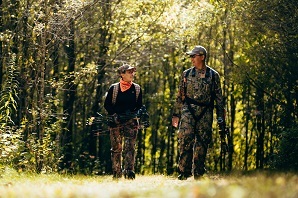Hunting and Trapping Newsletter
The New York State Department of Environmental Conservation sent this bulletin on 07/18/2023 03:15 PM EDT |
| DEC Delivers - Information to keep you connected and informed from the NYS Department of Environmental Conservation |
| View in browser |
Hunting and Trapping Newsletter |
Request for Game Camera Photos to Identify Wildlife Scavengers of Deer in New York
Lead is a poison that is harmful to wildlife and people. When lead-based ammunition is used to hunt white-tailed deer, lead fragments can remain in the meat, carcass, and gut piles, which can expose people and wildlife scavengers to lead. The New York Lead Ammunition Working Group was formed to help minimize risks from lead hunting ammunition for wildlife and people. This group is made up of the Department of Environmental Conservation, the Department of Health, Cornell University’s Wildlife Health Lab, the Venison Donation Coalition, the New York State Conservation Council, and Audubon New York. One of the group’s recommendations is to identify wildlife species that scavenge on deer remains (carcass, gut piles, other) that need to be prioritized for lead testing in New York. Cornell Wildlife Health Lab is leading this effort and we need your help! We are looking for game camera photos of a deer carcass or gut pile with at least one wildlife scavenger in frame, even if they are not actively feeding. If you have collected such photos in recent years and are willing to share a few suitable images, please take our short survey. The form allows you to upload up to 20 photos per game camera from a maximum of 5 game cameras. We are accepting photos only until August 13, so don’t wait to show us what you’ve found! Thank you very much for your participation and for helping to conserve wildlife populations! Estimating Bobcat Diversity
Once restricted to mountainous regions in eastern NY, bobcat populations have increased and expanded throughout central and western NY in recent decades. To effectively manage this elusive species, there is a need for better estimates of bobcat populations. DEC is currently using trail camera arrays to detect bobcats in several areas of interest throughout New York. Results from these camera surveys will be paired with a mark-resight analysis of ear-tagged and collared bobcats next year to estimate bobcat densities. If you happen to be out and about and come across a camera station, please do not disturb it. Stay tuned throughout this summer for highlight photos from this work, and a special thanks to all the private landowners who allowed cameras to be set up on their property! The lure being used to attract bobcats can trigger a rubbing response. So far, it seems that bobcats like it! Attention Lifetime Hunting License Holders
2023-24 Lifetime Hunting Licenses and tags are currently being mailed out. All Lifetime License holders should receive their tags by mid-August. In the meantime, you can verify that your license profile is up to date with your current email, mailing address and hunter education information by accessing your DECALS account online. If you do not receive your lifetime license documents by the end of August, you can replace them free of charge at a license issuing agent between August 28 and November 1. Remember, you do not need to have your license documents in hand to apply for deer management permits or purchase additional privileges when they go on sale in August! If you have any questions, please call our License Sales Office at 518-402-8843. Deer Management Assistance Program — Application Deadline is August 1
DEC’s Deer Management Assistance Program (DMAP) provides eligible landowners additional antlerless deer tags to distribute to licensed recreational hunters for use on the property during open deer hunting seasons. The program provides an additional tool to landowners to address deer impacts to agriculture, forest regeneration, unique natural areas, and municipalities, or meet custom deer management objectives. To be eligible, landowners or their designated agent must submit a DMAP application (PDF) by August 1 demonstrating that deer impacts or custom deer management objectives cannot be addressed through use of standard issue deer tags by hunters. Properties enrolled under the forest regeneration, unique natural areas, and custom deer management categories must meet minimum acreage requirements and/or submit a written management plan with their application. Once approved, DMAP permits remain valid for three years, but annual reporting is required to remain in the program. DMAP permittees must submit their annual report through DEC’s online DMAP reporting form after the deer hunting season. Participating hunters must also continue to report each harvested deer via DEC’s Game Harvest Reporting System. Learn more about DMAP, determine if you are eligible, and download the DMAP application (PDF). |




